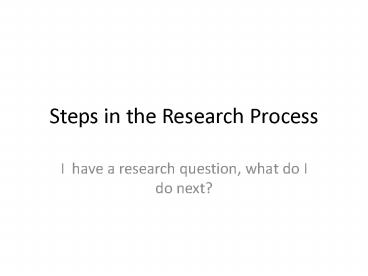Steps in the Research Process - PowerPoint PPT Presentation
1 / 13
Title:
Steps in the Research Process
Description:
Steps in the Research Process I have a research question, what do I do next? First things first .. Keep IRB issues in mind as you develop a plan Old data- New Data ... – PowerPoint PPT presentation
Number of Views:175
Avg rating:3.0/5.0
Title: Steps in the Research Process
1
Steps in the Research Process
- I have a research question, what do I do next?
2
First things first..
- Keep IRB issues in mind as you develop a plan
- Old data-
- New Data
- Retrospective data
- Continuing review is required annually until
project is closed . - Anonymous aggregate data (easiest method to
obtain approval) - Questions?
3
From initial idea to
- A specific question
- Some would argue this is the most difficult part
of developing your project - Find out what is already known.
- Identify what is not known, or what you can build
on (e.g. with a different population or technique)
4
Using existing Scholarly literature from your
discipline to specify your question
- Steps for a literature review
- Identify key terms
- Locate literature
- Critically evaluate and select the literature
- Organize the literature
- Write the review
5
The Research Process Data Collection
- Determine the data collection method
- Survey (web/paper considerations)
- Existing measures (reliability, validity)
- Interviews
- Under 18, over 18
6
What Permissions Are NeededObtaining Permission
- Campus approval (e.g., university or college) and
Institutional Review Board (IRB) - Individual participants
- Parents of participants who are not considered
adults
7
Linking Data Collection to Variables and
Questions
Flow of Activities
Example
Identify the variable
Self-efficacy for learning from others
Operationally define the variable
Level of confidence that an individual can learn
something by being taught by others
Locate data (measures, observations, documents
with questions and scales)
19 items on a self-efficacy scale from Zimmerman
(et al.
Scores of each item ranged from 0-10 with 10
being completely confident
Collect data on instruments yielding numeric
scores
8
At the manuscript stage-
- Be aware of how to interpret your findings based
on sample size and sampling techniques. - Probability sampling techniques to draw samples
representative of the population. - Nonprobability sample available, convenient
also may represent some characteristic the
investigator wants to study.
9
Populations and Samples
Target Population
Sample
Sample
Population - All teachers in high schools in one
city - College students in all community
colleges - Adult educators in all schools of
education
Sample - All high school biology teachers -
Students in one community college - Adult
educators in five schools of education in the
Midwest
10
Pedagogical Research
- potential measures of success
- Scores on in class exams or standardized measures
- Retention
- Survey results (interest, perception of gains in
learning, other attitudes) - Measures of skills
- ? (other ideas)
11
Types of Quantitative Sampling
Quantitative Sampling Strategies
Probability Sampling
Nonprobability Sampling
Simple Systematic Stratified
Multistage Random Sampling Sampling
Cluster Sampling
Sampling
Convenience Snowball Sampling
Sampling
12
The Types of Survey Designs
Time of Data Collection
Study Over Time
Study at One Point in Time
Longitudinal
Cross-sectional
Attitudes and Practices
Community Needs
Program Evaluation
Follow students (or instructors) Over time
Group Comparisons
National Assessment
13
Choosing instruments Reliability Validity
- Reliability Scores from measuring variables
that are stable and consistent - Example Bathroom scale
- Validity Do the items on the scale meaningfully
represent your construct?































